- Top
- Merries Baby Skin Research Room
- Merries was born from skin research
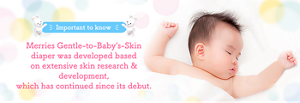

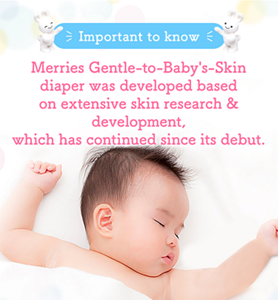
We want to see as many baby smiles as possible.
With this in mind,
Merries is committed on continuous research and development with the aim of making Merries the world's most “baby-friendly” diaper.
Here, together we walk you through the history,
background and activities conducted on skin-related research
- the secret behind Merries diapers.



Merries' Skin Research
~4 thoughts~
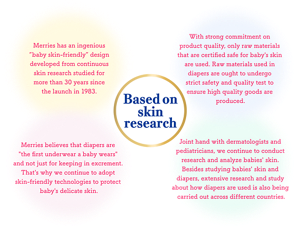

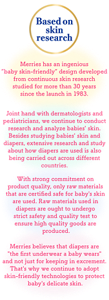
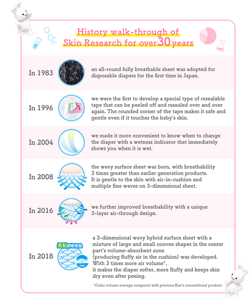

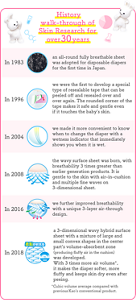



How was Merries’ skin-friendliness developed?
All the research and development effort stems from Kao's aim to continue the pursuit of material selection and design in consideration of baby's skin,
as well as providing thorough safety and quality management.
Kao researchers are focused on one ultimate goal
- making diapers that are most skin-friendly.



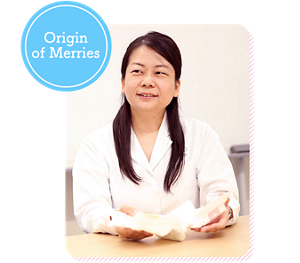
Why are we so particular about breathability?
Mina Tomita,
from Kao Sanitary Research Institute.
The most important factor when producing diapers is to minimize “wetness, stuffiness, and rubbing”. We consider these are the main factors that lead to discomfort on baby’s skin.
Read more
"Breathability" aspect is very important to provide comfort to your baby. When disposable diapers become widely available & being mass produced in late 1970s, breathability has not been emphasized as one of the key aspects. Under such circumstances, Kao Japan has then launched its first diaper equipped with "fully breathable sheet" in 1983, called "Merries". A survey conducted at that time found that there was an issue with stuffiness and moisture which can irritate baby's skin. From there, we have started the thorough research about baby's skin and recognizes the importance of breathability to reduce the stuffiness and keep baby's skin dry.
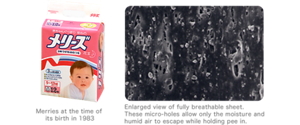

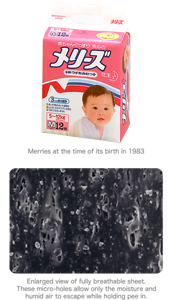
Years after years of research
in consideration of Baby's Skin
Ever since then, research and development has been continuously conducted to improve gentleness to the skin. In 2008, we redesigned the flat surface sheet (the part that is in direct contact with baby's skin) to wavy surface sheet. This has largely reduced the contact with baby's skin and ensuring a passage for air to flow through, which has successfully improved the breathability. It took about 4 years from idea conceptualization to completion. Subsequently in 2016, we developed a "3-layer air through system" with all 3 layers of diapers are fully breathable. Moreover in 2018, we also developed a unique "3-dimensional wavy hybrid surface sheet" that are made of 2 convex shapes. Large convex shape (fluffy air in a cushion) are mounted in the center part allow 3 times more air volume* to flow through and improves the softness on skin. The wavy surface allows soft contact to baby's skin, making it easier to move around and reducing the friction. In addition, both side parts are made of small convex shapes (multiple fine waves that form convex-concave shapes) to prevent spreading of pee and poo around diaper and prevent leakage.
*Cubic volume average compared with previous Kao's conventional product
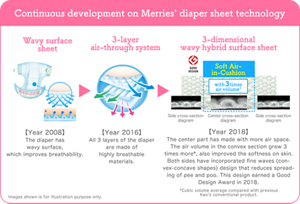


These improvements took around 4 years time to establish. The reason why it took so long is that every single modification needs to get through various verification points and meet Kao's strict standards. Successful prototypes are made from multiple times of prototypes production, measuring on physical characteristics and trial and error experiments. Thereafter, good prototypes are tried on babies, several results on moisture level, water content on the skin etc. are measured under various conditions. Based on the experiment results, further adjustments are made until the finished products are put on the production line. The processes of which ultimate finished products undergo signify the passion within our researchers to realize their wish to "make diapers that are most skin-friendly".
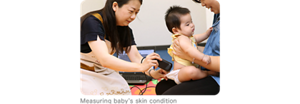

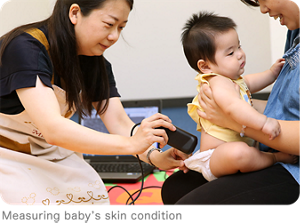
“Skin-friendly” is a universal need
Customer needs are constantly evolving, as such regular fact-check and survey is compulsory. Along with Merries' global expansion plan, our researchers are also actively conducting fact-check surveys at oversea. We are always amazed by the differences in living environment and parenting habits from the survey results. Nevertheless, the need for “skin-friendly” products is always high on the list in Japan as well as other countries. Therefore we will continue to make efforts to minimize “wetness, stuffiness, and rubbing” based on various perspectives, with the aim of improving breathability. Of course, to reduce “wetness, stuffiness, and rubbing” to 0 is a tough task, but we believe that is our mission to continue pursue this endless challenge.



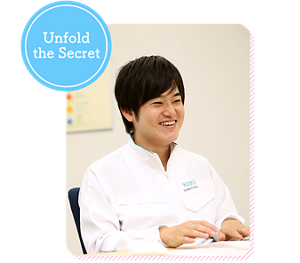
What is skin-friendly material?
Masayuki Minatozaki,
from Kao Sanitary Research Institute.
A baby’s skin is very delicate, as baby's skin is only half as thick as an adult's skin. Skin that feels smooth and soft actually has weak barrier function.
Read more
As a part of materials research, I face these problems every day and aim to develop materials that are gentle to a baby’s skin. The surface sheet that comes into direct contact with the baby’s bottom is the most important material, especially its “breathability and softness”. For that purpose, it is necessary to study the fibers down to the micro level to develop a suitable non-woven fabric as the material for the surface sheet.
Achievement on high level of breathability and softness
For example, when making a soft non-woven fabric, if thick fibers are used, it is easy to create a space between the fibers and a fluffy non-woven fabric can be made, however, the texture is not desirable. On the other hand, fine fibers can be used to create a smooth, non-woven fabric that feels good next to the skin, but the gap between the fibers is eliminated, which reduces fluffiness, breathability, and absorbency. In order to achieve both breathability and softness at a high level, it is necessary to combine various types of fibers to make a non-woven fabric and then its physical properties must be verified.
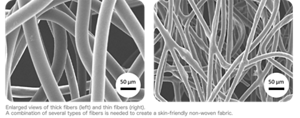

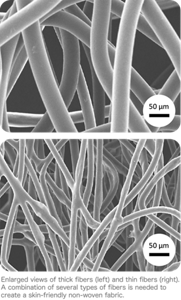
Also, even when a good non-woven fabric is finally produced in the laboratory after many trials and experiments, and put up on a non-woven fabric manufacturing line, you will still get different results in real-life situations as compared to the results from laboratory. Therefore, it is necessary to return to the lab again. Only when all the requirements and the standards are met can it be called a skin-friendly material. During the development of “Fluffy Air-in-Cushion”, released in the fall of 2018, it was a difficult challenge to search for a material that improves the softness of the surface, while also having large protrusions.
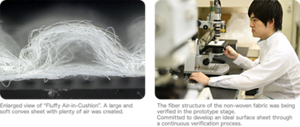

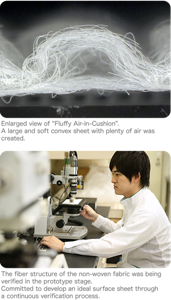
Understand the present need for research
and development
Another thing that is important for research and development of materials is the consideration of the present needs of families. At Kao, we regularly conduct fact-finding surveys on actual households to understand usage of our products, as the needs of our customers change over time. For example, over the last few years, usage of a baby carrier worn in front has spread rapidly, the number of working moms has increased, and parenting style has changed. It’s hard to observe such changes by staying in the lab and doing research. That is why we try to always remain aware of whether the evaluations made in the lab are suitable for the present era. Also, a material created by looking only at your own research data may not be a “skin-friendly” material for others. We listen to voices from the real world and try to provide answers that match the current situation. As we progress along with the times, we intend to provide products that fit the lifestyle of our customers.



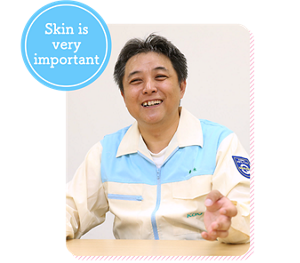
Prioritize on quality, safe for skin
Hiromichi Suzuki,
from Kao Technology Development Center
Safety and quality control are extremely important for providing diapers that come into direct contact with baby's skin to our customers.
Read more
I am currently working on technology and materials that made up the diapers, which is in other words, the final pillar for quality control. Mistakes cannot be tolerated. We must faithfully produce based on the blueprints created in the lab. That may seem like a simple task, but it’s actually quite difficult.
Prevent minor errors by making full use of machines as well as human eyes
This is because with non-woven fabric, the main type of material used for diapers, a “margin error” of its physical characteristics by about 10% is common. A total of about 20 different types of those materials are combined to form a single diaper, so if you put them in a mass-production manner, the final production will inevitably have “margin error”. This is an area where no matter how much research we do in the lab, we will not know until we actually produce the product. In order to avoid a less than ideal result, we have installed hundreds of sensors along the production line and check every process, such as the size and shape of each part, the joint, etc. Ultimately, we also check it personally and must solve any problem ourselves. Fortunately, there are many skilled workers at our production site who can be called as “specialists”. If there is a problem, people at the production site, including myself, along with researchers at the laboratory work together to investigate the cause and solve the issue. At the final stage, a member of the quality control department checks the finished product. By undergoing such flow, a product can only be released after approved and checked by many departments.
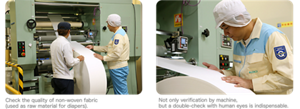

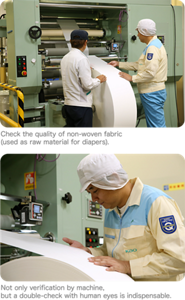
Only materials that have met strict safety standards
In order to ensure safety, the materials must pass through examination stage before entering into the production site. I have been in the lab before and the standards are strict. In cooperation with the department that evaluates safety, the process from the fiber stage to production of non-woven fabric is checked repeatedly. Of course, we also do skin allergy tests and safety tests are conducted by an external organization. After all series of checking, we will only perform trials by using diaper on a baby. During the trial, doctor will examine the condition of the skin before and after wearing the diaper. I believe that Kao’s standards on the safety level are among the highest in the world.
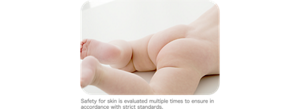

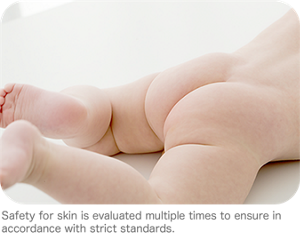
“Provide products that are very gentle on baby’s skin”. There are more than 100 people involved in the process, from lab work to production, and this is their shared mindset. We hope that you will be able to use Merries with peace of mind by understanding the actual conditions and aims of our manufacturing process.



- Top
- Merries Baby Skin Research Room
- Merries was born from skin research



